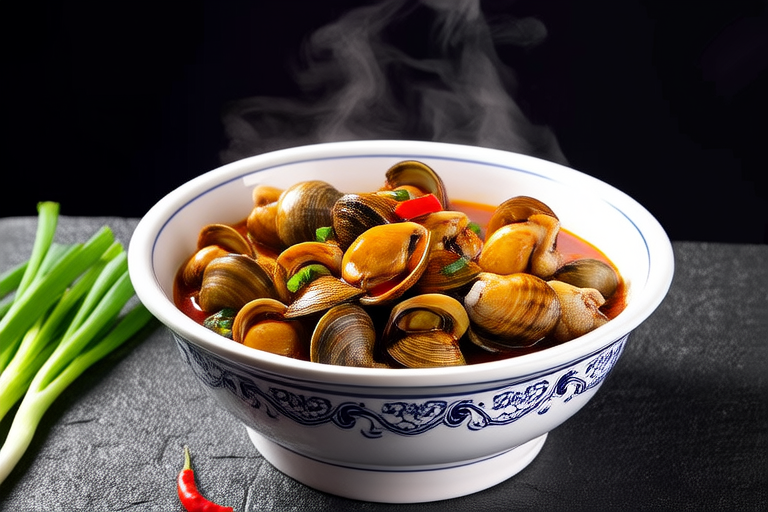Traditional Anhui Delicacy: Stewed River Snails
Introduction:
Anhui cuisine, one of the eight major cuisines in China, is renowned for its emphasis on local ingredients and traditional cooking methods. Among the many delicacies, stewed river snails stand out as a classic dish that perfectly encapsulates the essence of Anhui’s culinary heritage. This dish not only showcases the rich flavors of the region but also reflects the deep-rooted connection between Anhui people and their natural surroundings. In this article, we will delve into the history, preparation techniques, and nutritional benefits of this beloved dish.
The History of Stewed River Snails
Stewed river snails have been a staple in Anhui cuisine for centuries. The dish has its roots in the Huai River basin, where river snails were abundant and considered a delicacy. Historically, the dish was prepared by rural families who lived near rivers and streams, using locally sourced ingredients to create a simple yet flavorful meal. Over time, the recipe evolved, with chefs adding various spices and herbs to enhance the taste. Today, stewed river snails are enjoyed not only in Anhui but across China and even internationally, thanks to the growing popularity of Chinese cuisine.
Ingredients
- River snails (about 1 kg)
- Garlic (4 cloves)
- Ginger (a small piece)
- Scallions (2 stalks)
- Soy sauce (2 tablespoons)
- Shaoxing rice wine (1 tablespoon)
- Sugar (1 teaspoon)
- Vinegar (1 tablespoon)
- Chili paste (optional, according to taste)
- Vegetable oil (for frying)
- Water (as needed)
In addition to these primary ingredients, you may also want to prepare some optional garnishes such as chopped scallions or sesame seeds for extra flavor.
Preparation Steps
- Cleaning the Snails: Begin by thoroughly cleaning the river snails. Place them in a large bowl of saltwater for about 30 minutes to allow them to expel any dirt or impurities. Afterward, rinse them under running water and use a small brush to scrub off any remaining debris.
- Preparing the Seasonings: While the snails are soaking, finely chop the garlic, ginger, and scallions. Set aside the chopped vegetables for later use.
- Boiling the Snails: Once cleaned, transfer the snails to a pot and cover them with fresh water. Bring the water to a boil over high heat and let it simmer for about 10 minutes. This step helps to further clean the snails and remove any remaining impurities.
- Stir-Frying the Aromatics: Heat a wok or pan over medium-high heat and add a generous amount of vegetable oil. When the oil is hot, add the chopped garlic, ginger, and scallions. Stir-fry until fragrant, being careful not to burn the garlic.
- Adding the Snails: Next, carefully pour the boiled snails and their liquid into the wok. Add soy sauce, Shaoxing rice wine, sugar, vinegar, and chili paste if desired. Stir everything together well to ensure all the snails are coated evenly with the sauce.
- Simmering: Reduce the heat to low and let the mixture simmer gently for approximately 30 minutes. During this time, the flavors will meld together, creating a rich and savory broth that perfectly complements the snails.
- Serving: Once the snails are tender and the sauce has thickened slightly, turn off the heat. Transfer the stewed river snails to a serving dish and garnish with additional chopped scallions or sesame seeds if desired. Serve immediately while hot.
Nutritional Value
Stewed river snails are not only delicious but also highly nutritious. They are an excellent source of protein, providing around 15 grams per serving. Additionally, they contain essential minerals such as iron, calcium, and phosphorus, which are important for maintaining healthy bones and preventing anemia. The vitamins found in the snails, particularly vitamin B12, contribute to overall health and energy levels. However, it is worth noting that some individuals may be allergic to shellfish, so it is advisable to consult a doctor before consuming this dish if you have any concerns.
Health Benefits
Regular consumption of stewed river snails can offer several health benefits. Firstly, the high protein content makes them an ideal food for muscle building and repair. Secondly, the presence of omega-3 fatty acids promotes heart health by reducing inflammation and lowering blood pressure. Furthermore, the antioxidants present in the dish help protect against cellular damage caused by free radicals, potentially slowing down the aging process. Lastly, the combination of spices used in the preparation can aid digestion and improve gut health.
Conclusion
Stewed river snails represent more than just a tasty dish; they symbolize the rich cultural heritage of Anhui province. By following this detailed guide, you can recreate this authentic Anhui delicacy at home and experience firsthand why it has remained popular for generations. Whether you’re a seasoned chef or a novice cook, preparing stewed river snails is sure to impress your guests and satisfy your palate.


